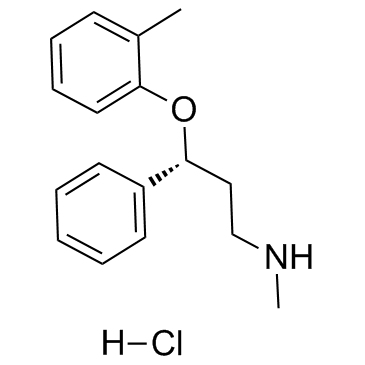Physical exercise and catecholamine reuptake inhibitors affect orienting behavior and social interaction in a rat model of attention-deficit/hyperactivity disorder.
Andrea M Robinson, Rachel L Eggleston, David J Bucci
文献索引:Behav. Neurosci. 126(6) , 762-71, (2012)
全文:HTML全文
摘要
The effects of methylphenidate (MPH), atomoxetine (ATMX), and/or physical exercise (EX) on orienting behavior and social interaction were examined in spontaneously hypertensive rats (SHRs), a commonly used animal model of attention-deficit/hyperactivity disorder (ADHD). During the orienting procedure, rats received repeated presentations of a nonreinforced visual stimulus. As observed previously, orienting behavior (rearing up on the hind legs) habituated across trials in normo-active control rats (Wistars) but not in SHRs, suggesting that SHRs have difficulty ignoring irrelevant behavioral stimuli. Treatment with MPH (0.125 mg/kg), ATMX (0.125 mg/kg), or EX (3 weeks of access to a running wheel), alone or in combination, reduced rearing behavior in SHRs to the level observed in the Wistar control group. Similarly, drug treatment and/or EX reduced the number of social interactions exhibited by SHRs, while having no effects on locomotor activity. It is important to note that EX was just as effective as MPH or ATMX in reducing orienting behavior and social interaction. In contrast to the SHRs, neither MPH nor ATMX affected orienting or social behavior in Wistar rats. Together, these findings support the growing literature that EX may be useful as an adjunctive or replacement therapy in ADHD.
相关化合物
| 结构式 | 名称/CAS号 | 分子式 | 全部文献 |
|---|---|---|---|
 |
盐酸托莫西汀
CAS:82248-59-7 |
C17H22ClNO |
|
Methylphenidate and atomoxetine inhibit social play behavior...
2015-01-07 [J. Neurosci. 35(1) , 161-9, (2015)] |
|
Atomoxetine prevents dexamethasone-induced skeletal muscle a...
2014-12-01 [J. Pharmacol. Exp. Ther. 351(3) , 663-73, (2014)] |
|
Current pharmacotherapy of attention deficit hyperactivity d...
2013-10-01 [Drugs Today (Barc) 49(10) , 647-65, (2013)] |
|
[ADHD register: post-marketing evaluation of the benefit-ris...
2013-06-01 [Recenti Prog. Med. 104(6) , 254-61, (2013)] |
|
[Life-threatening heart failure caused by ADHD medication. F...
2012-12-01 [Lakartidningen. 109(45) , 2016-8, (2012)] |